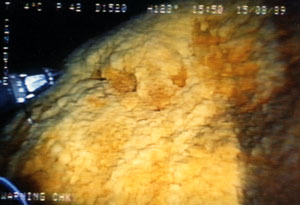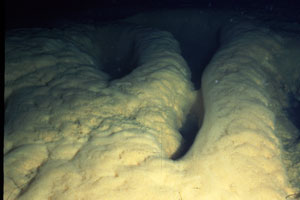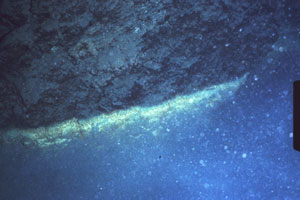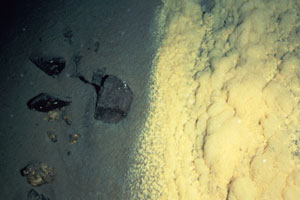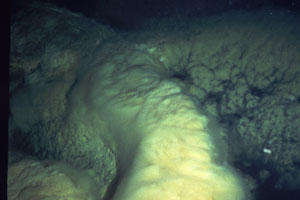Studies of Hydrothermal Processes in Crater Lake, Oregon – extracted from OSU College of Oceanography Report #90-7
Summary: Observations Related to Active Hydrothermal Features
Measurements of temperature and salt content within the South Basin of Crater Lake show surprising variations over distances of a few meters. These thermal and salinity gradients can only be maintained by a continuing input of anomalous fluids.
Communities of bacteria, which produce impressive mat features on rock outcrops and sediment surfaces, mark sites of deep lake venting. The mats have internal temperatures which are more than 15°C higher than lake bottom water. These communities apparently use the abundant reduced iron in the advecting fluids to fuel their metabolism. Although there were no visible indications of fluid flow through or from the mats, fluid advection is necessary in order to provide the continuous input of reduced chemical species which is required for the survival of these prolific bacterial communities. The temperature gradients within the mats indicate that the advection rates are as high as 100 meters per year. Consequently, the bacterial mats are visual markers of thermally and chemically enriched fluid venting.
Pools of saline water, with major element contents that are approximately ten times greater than background lake values, have been discovered in two widely separated areas of the lake. Sediment pore water compositions from some South Basin cores are similar to those of the pools. The pore water measurements define non-linear gradients which indicate vertical fluid advection rates of up to two meters/year. These measurements as well as the major element compositions suggest that the fluids advecting through the sediments, the brine pools, and the bacterial mats are derived from a similar source. Results from chemical geothermometry determinations suggest that this source equilibrated with silicate rocks at temperatures ranging from 40 to 165 °C. In addition to these expressions of active inputs, we discovered inactive silica-rich spires over 10 meters tall, located on the lake floor near the base of Skell Head. Their morphology and chemistry suggests they were formed underwater during earlier hydrothermal episodes.
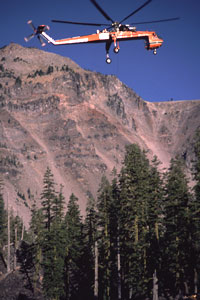 Sampling of the mat fluids, the brine pools, and sediment pore waters has dramatically increased the known range of anomalous water compositions within Crater Lake. In the most anomalous fluids manganese is enriched by as much as a million times and Radon is enriched 100,000 times over typical lake values. Helium-3, perhaps the most distinctive indicator of a magmatic source, is enriched 500 times over values for waters in equilibrium with the atmosphere. Striking depletions of C-14 in pool fluids and the deep lake waters indicate a magmatic source of “dead carbon” is entering the deep lake. Rare earth element concentrations in lake and sediment pore waters have an abundance pattern which indicate a hydrothermal source. Isotopic compositions of hydrogen in the saline pools clearly show that these anomalous fluids are highly modified lake water and could not have originated outside the lake.
Sampling of the mat fluids, the brine pools, and sediment pore waters has dramatically increased the known range of anomalous water compositions within Crater Lake. In the most anomalous fluids manganese is enriched by as much as a million times and Radon is enriched 100,000 times over typical lake values. Helium-3, perhaps the most distinctive indicator of a magmatic source, is enriched 500 times over values for waters in equilibrium with the atmosphere. Striking depletions of C-14 in pool fluids and the deep lake waters indicate a magmatic source of “dead carbon” is entering the deep lake. Rare earth element concentrations in lake and sediment pore waters have an abundance pattern which indicate a hydrothermal source. Isotopic compositions of hydrogen in the saline pools clearly show that these anomalous fluids are highly modified lake water and could not have originated outside the lake.
The enhanced salt content of the anomalous fluids enables us to account for the bulk composition of the lake by elucidating the sources of chemical species which were previously unexplained by known water sources such as precipitation and caldera springs. We have identified a third source—a hydrothermal component—as the major influence on lake composition. Using sensitive analytical methods, we have monitored the active accumulation of heat and salt in the deep lake that results from this source. Various mass balance models indicate that a net heat flow of 15 to 30 megawatts (MW) is carried into the lake by thermal fluids. The calculated flow rates for a thermally and chemically enriched fluid are approximately 200-400 liters/second—roughly two billion gallons per year.
Other pages in this section
*** previous title *** --- *** next title ***

